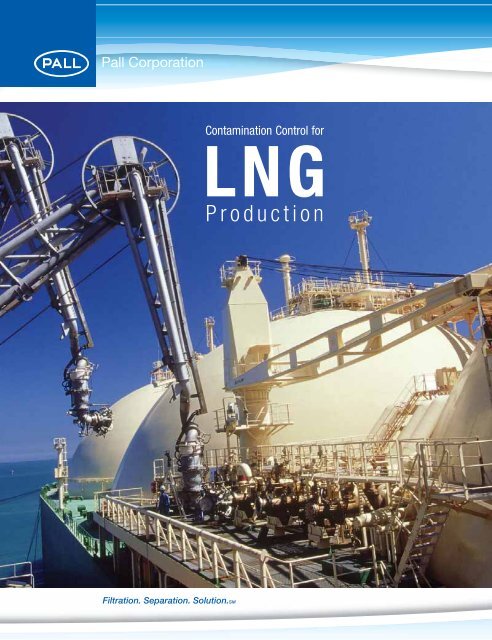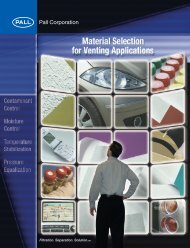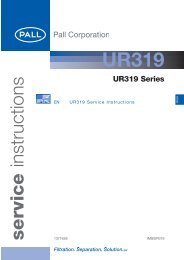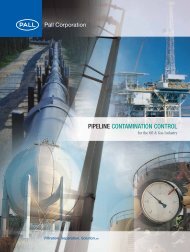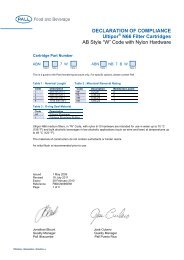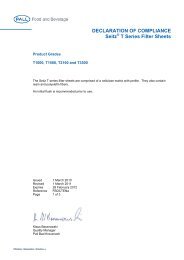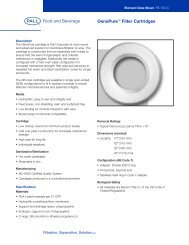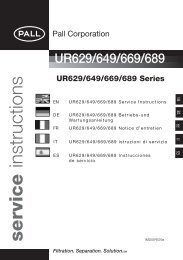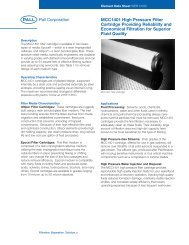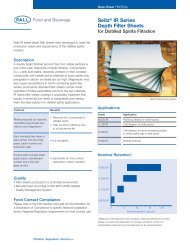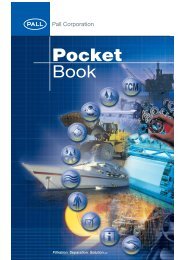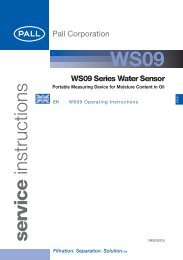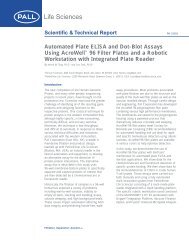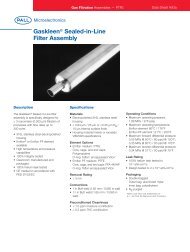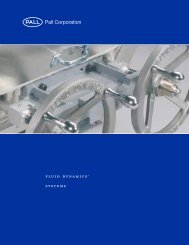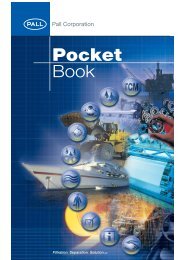Contamination Control for LNG Production - Pall Corporation
Contamination Control for LNG Production - Pall Corporation
Contamination Control for LNG Production - Pall Corporation
Create successful ePaper yourself
Turn your PDF publications into a flip-book with our unique Google optimized e-Paper software.
<strong>Contamination</strong> <strong>Control</strong> <strong>for</strong><br />
<strong>LNG</strong><br />
<strong>Production</strong>
<strong>Pall</strong> <strong>Contamination</strong> <strong>Control</strong> <strong>for</strong> <strong>LNG</strong> <strong>Production</strong><br />
Natural gas is a clean-burning fuel<br />
that emits lower levels of potentially<br />
harmful byproducts than heating oil or<br />
coal. Because it is clean and safe, its<br />
use is increasing in residential, commercial,<br />
and industrial settings. An<br />
important component of the world's<br />
energy supply, natural gas will continue<br />
to play a major role in the energy<br />
arena <strong>for</strong> years to come.<br />
The Demand <strong>for</strong> Natural Gas Continues to Grow<br />
In the United States, natural gas accounts <strong>for</strong> about onequarter<br />
of all energy used. Its role is large and growing.<br />
According to the 2005 Annual Energy Outlook, prepared<br />
by the Energy In<strong>for</strong>mation Administration (EIA) of the U.S.<br />
Department of Energy, the demand <strong>for</strong> natural gas will<br />
increase more than 38 percent by 2025. This rapid rise in<br />
demand is due largely to increased consumption by new<br />
and existing electric generating plants running at higher<br />
capacities. Natural gas offers distinct advantages over<br />
generators fueled by coal; these include lower capital<br />
costs, lower emissions, and higher fuel efficiencies.<br />
Consumption in other large, energy-driven countries follows<br />
a similar pattern, since natural gas is increasingly<br />
being used to meet overall energy needs.<br />
Reserves are Abundant but Remotely Located<br />
The good news is that the world’s natural gas reserves<br />
are extensive. These reserves will continue to satisfy the<br />
growing worldwide demand over the next several<br />
decades. The challenge, however, is that Russia, Iran, and<br />
Qatar combined hold more than 55 percent of the world’s<br />
natural gas reserves. With over half of the reserves located<br />
in areas of the world far from consuming markets, the<br />
biggest challenge becomes one of transportation. How<br />
can producers transport their natural gas to areas of need<br />
in a cost-effective, efficient way?<br />
Economical Transportation of Natural Gas Relies on<br />
Liquefaction<br />
The conversion of natural gas into liquid is called liquefaction<br />
and is achieved through refrigeration. Liquefaction<br />
reduces the volume of the gas by approximately 600<br />
times, making it more economical to transport on a global<br />
scale. After the natural gas is converted to liquid, it is<br />
placed in rein<strong>for</strong>ced containers and loaded onto specially<br />
designed ships, all meeting strict safety and security standards.<br />
When the ship reaches its destination, called a<br />
receiving terminal, the liquefied natural gas (<strong>LNG</strong>) is then<br />
converted back to gas and stored in specialty tanks. This<br />
is accomplished by warming the liquid during a process<br />
known as regasification. <strong>LNG</strong> is the answer <strong>for</strong> natural<br />
gas producers who need to ship their product over the<br />
ocean to countries where pipeline transportation is not<br />
feasible.<br />
<strong>LNG</strong> Producers Use Filtration to Increase <strong>Production</strong><br />
The challenge <strong>for</strong> <strong>LNG</strong> producers is to maximize their output<br />
and, in some cases, expand their facilities to meet the<br />
increasing demand <strong>for</strong> natural gas. Filtration plays an<br />
important role in this ef<strong>for</strong>t. <strong>LNG</strong> producers can optimize<br />
their yields through the strategic placement of filtration<br />
products developed with advanced filtration and separation<br />
technologies. <strong>Pall</strong> will work with you to find the right<br />
solutions <strong>for</strong> the challenges presented by your specific<br />
<strong>LNG</strong> system.<br />
2
Practical Solutions <strong>for</strong> Customers Around the Globe<br />
<strong>Pall</strong> <strong>Corporation</strong> solves complex contamination, separation,<br />
and purification problems. We serve oil and gas,<br />
refinery, chemical, and polymer markets around the world.<br />
With <strong>Pall</strong> products and services, you can satisfy regulatory<br />
requirements and increase output while reducing total<br />
cost of ownership. Our enabling technologies help make<br />
customers’ products better and safer, and may even<br />
make them possible.<br />
<strong>Pall</strong> is much more than a filter company. We are fluid<br />
management specialists, leveraging our unmatched capabilities<br />
to make customers’ operations more successful.<br />
Our expertise has enabled us to build a large library of<br />
proprietary core materials, which we can modify to separate,<br />
remove, or selectively capture the most elusive contaminants.<br />
<strong>Pall</strong> has the ability to design, manufacture, and install<br />
economical, integrated systems as well as service them.<br />
Our systems can cost-effectively treat all of the incoming<br />
process and waste streams in your plant. We can offer<br />
these solutions to customers—whether in oil and gas production,<br />
oil refining, gas processing, chemical production,<br />
or polymer processing—around the globe. By meeting<br />
critical needs, we build lasting customer relationships that<br />
grow stronger year after year.<br />
To help our customers improve per<strong>for</strong>mance and reach<br />
higher goals, we have developed a comprehensive<br />
approach to treating your <strong>LNG</strong> plant, called Total Fluid<br />
Management SM (TFM), that leverages our strengths and<br />
provides you with real value.<br />
Our customized system services include:<br />
• Process audits/consultancy<br />
• Customized product development<br />
• Training seminars<br />
• Testing/piloting<br />
• System maintenance/service contracts<br />
We invite you to learn more about <strong>Pall</strong>’s wide array of<br />
products and customized system and productivity services<br />
<strong>for</strong> Total Fluid Management. Contact your <strong>Pall</strong> representative<br />
or visit us on the web at www.pall.com.<br />
3
Filtration Recommendations <strong>for</strong> Liquefied Natural Gas<br />
The adjacent schematic represents a typical flow of gas within an <strong>LNG</strong> production<br />
facility. Each <strong>Pall</strong> solution within the flow diagram is labeled and described<br />
in the charts that follow. For more detailed descriptions of <strong>Pall</strong> products used in<br />
the fuels and chemicals markets, please visit us on the web at<br />
http://www.pall.com/chemical.asp.<br />
<strong>Pall</strong> Liquid/Gas Coalescers<br />
Application Challenge Solution<br />
1. Amine contactor protection Prevent hydrocarbon and solid aerosols from Install liquid/gas coalescers to remove<br />
contaminating the amine system, which could liquid droplets and solids from the<br />
result in foaming, solvent losses, and<br />
gas be<strong>for</strong>e it enters the amine system.<br />
off-specification gas.<br />
2. Glycol contactor protection Prevent amine, hydrocarbon, and solid aerosols Install liquid/gas coalescers to remove<br />
from contaminating the glycol system, liquid droplets and solids from the<br />
which could result in foaming, solvent gas be<strong>for</strong>e it enters the glycol system.<br />
losses, and off-specification gas.<br />
Recover carryover amine <strong>for</strong> reuse.<br />
3. Compressor protection Improve reliability of the compressor by Install liquid/gas coalescers to remove<br />
preventing fouling from liquid and solid liquid droplets and solids from the<br />
aerosols.<br />
gas be<strong>for</strong>e internal parts of the<br />
compressor are fouled or damaged.<br />
4. Condenser/main <strong>LNG</strong> Protect the refrigerant condenser and main Install liquid/gas coalescers downstream of the<br />
heat exchanger protection <strong>LNG</strong> heat exchanger from fouling. compressor to remove carryover lube oil.<br />
5. Molecular sieve drier Increase cycle time between regeneration Install liquid/gas coalescers to remove<br />
protection of the molecular sieve drier and extend liquid droplets and solids from the<br />
the bed life.<br />
gas be<strong>for</strong>e they foul the molecular<br />
sieve drier.<br />
4
<strong>Pall</strong> Liquid/Liquid Coalescers<br />
Application Challenge Solution<br />
6. Rich amine Improve the reliability of the amine Install liquid/liquid coalescers to remove<br />
regenerator by removing foulants in the hydrocarbons from the amine solvent<br />
amine solvent.<br />
prior to the regenerator.<br />
7. Condensate water Provide condensate water free of Install liquid/liquid coalescers to remove the<br />
hydrocarbons.<br />
hydrocarbon from the condensed water.<br />
<strong>Pall</strong> Gas Particle Filters<br />
Application Challenge Solution<br />
8. Mercury removal unit (MRU) Protect MRU bed from fouling with fine particles Install gas particle filters to effectively<br />
protection that carry over from the molecular sieve bed. remove any carryover molecular sieve particles.<br />
9. Main <strong>LNG</strong> heat exchanger Protect the main <strong>LNG</strong> heat exchanger Install gas particle filters to effectively<br />
protection from fouling due to carryover MRU fines. remove any carryover MRU fines.<br />
<strong>Pall</strong> Liquid Particle Filters<br />
Application Challenge Solution<br />
10. Prefiltration prior to liquid/liquid Ensure that the liquid/liquid coalescer Install high-efficiency particle filters<br />
coalescer has a service life of one year or more. upstream of the liquid/liquid coalescers.<br />
11. Upstream carbon bed in amine Protect the carbon bed from plugging Install high-efficiency particle<br />
or glycol with solids. filters upstream of the carbon bed.<br />
12. Downstream of carbon bed in Remove any carbon fines from the carbon Install high-efficiency particle filters<br />
amine or glycol bed that could bleed into the amine or glycol. downstream of the carbon bed.<br />
5
What Separation Equipment to Use<br />
<strong>Pall</strong> Liquid/Gas Coalescers<br />
Per<strong>for</strong>ming with maximum removal efficiency and economy, <strong>Pall</strong> liquid/gas coalescers reduce equipment downtime<br />
as well as decrease labor and maintenance costs. They have a unique fiber medium matrix that contains increasing<br />
pore sizes. This design allows small droplets in the incoming gas to merge (coalesce) into larger drops that are<br />
easier to separate. The medium enables single-stage coalescing to separate difficult liquid aerosols. Our liquid/gas<br />
coalescers are specially treated with a fluoropolymer coating to improve the drainage of liquids through the coalescer.<br />
As a result, smaller assemblies can be used, and up-front capital costs are minimized. The fluoropolymer<br />
treatment also lowers operating costs by allowing the coalescer to operate at a lower liquid saturated pressure<br />
drop and recover quickly from process upsets.<br />
<strong>Pall</strong> products: SepraSol liquid/gas coalescers, SepraSol Plus liquid/gas coalescers<br />
<strong>Pall</strong> Liquid/Liquid Coalescers<br />
<strong>Pall</strong> liquid/liquid coalescers are designed to efficiently separate liquid/liquid emulsions. They are constructed of a variety<br />
of polymers and fluoropolymers, offering a wide range of compatibility. These high-efficiency coalescers are effective<br />
in systems with low interfacial tension without disarming or being compromised by the presence of surfactants.<br />
A patented vertical stack design is used with a coalescer/separator configuration, allowing an even flow distribution.<br />
This permits a high flow rate in a smaller assembly.With long service life, the coalescer cartridges require fewer changeouts,<br />
thereby reducing maintenance and disposal costs. A horizontal design is also available <strong>for</strong> use in oil from amine<br />
separations and <strong>for</strong> very low interfacial emulsions.<br />
<strong>Pall</strong> products: AquaSep ® Plus liquid/liquid<br />
coalescers, PhaseSep ® liquid/liquid coalescers<br />
<strong>Pall</strong> Gas Particle Filters<br />
Small solid aerosols from gas streams, including desiccant<br />
fines, iron oxides, iron sulfides, and other particles,<br />
can foul instruments, valves, compressors, heat exchangers<br />
and other critical system components. <strong>Pall</strong> gas particle<br />
filters (GPF) are used to remove these particles,<br />
eliminating a primary source of the contamination that<br />
causes system failures.<br />
<strong>Pall</strong> products: Epocel ® filters, Ultipor ® filters,<br />
coreless Profile ® filters<br />
<strong>Pall</strong> Liquid Particle Filters<br />
<strong>Pall</strong> liquid particle filters (LPF) are used to remove contaminant<br />
particles from a liquid stream. The presence of<br />
these particles can lead to excessive pump wear, heat<br />
exchanger fouling, contactor foaming, and regenerator<br />
fouling. They can also shorten the life of the coalescer<br />
and carbon bed. The removal of these particles is preventive<br />
maintenance, which is an important part of an<br />
overall maintenance program.<br />
<strong>Pall</strong> products: Ultipleat ® High Flow filters; Marksman<br />
filters; coreless Profile filters, Nexis ® filters, and Claris ®<br />
filters<br />
United States<br />
25 Harbor Park Drive<br />
Port Washington, New York 11050<br />
888.873.7255 toll free<br />
516.484.3600 phone<br />
516.484.0364 fax<br />
fuelsandchemicals@pall.com<br />
United Kingdom<br />
Europa House, Havant Street<br />
Portsmouth PO1 3PD<br />
Hampshire, England<br />
+44 (0) 23 9230 2357 phone<br />
+44 (0) 23 9230 2509 fax<br />
processuk@pall.com<br />
Visit us on the Web at www.pall.com/chemical.asp<br />
<strong>Pall</strong> <strong>Corporation</strong> has offices and plants throughout the world in locations including:<br />
Argentina, Australia, Austria, Belgium, Brazil, Canada, China, France, Germany, India, Indonesia, Ireland,<br />
Italy, Japan, Korea, Malaysia, Mexico, the Netherlands, New Zealand, Norway, Poland, Puerto Rico,<br />
Russia, Singapore, South Africa, Spain, Sweden, Switzerland, Taiwan, Thailand, United Kingdom,<br />
United States, and Venezuela. Distributors are located in all major industrial areas of the world.<br />
© Copyright 2006, <strong>Pall</strong> <strong>Corporation</strong>. <strong>Pall</strong>, , AquaSep, Claris, Epocel, Marksman, Nexis, PhaseSep, Profile,<br />
SepraSol, Ultipleat and Ultipor are trademarks of <strong>Pall</strong> <strong>Corporation</strong>. ® Indicates a <strong>Pall</strong> trademark registered in the USA.<br />
and Total Fluid Management are service marks of <strong>Pall</strong> <strong>Corporation</strong>.<br />
FC<strong>LNG</strong>EN<br />
10/06 • 2M • ASP


